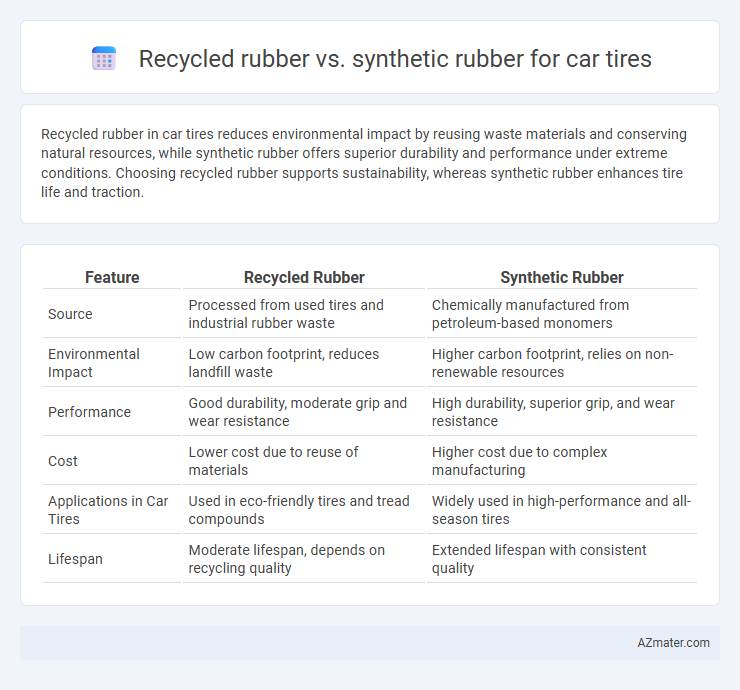Recycled rubber in car tires reduces environmental impact by reusing waste materials and conserving natural resources, while synthetic rubber offers superior durability and performance under extreme conditions. Choosing recycled rubber supports sustainability, whereas synthetic rubber enhances tire life and traction.
Table of Comparison
| Feature | Recycled Rubber | Synthetic Rubber |
|---|---|---|
| Source | Processed from used tires and industrial rubber waste | Chemically manufactured from petroleum-based monomers |
| Environmental Impact | Low carbon footprint, reduces landfill waste | Higher carbon footprint, relies on non-renewable resources |
| Performance | Good durability, moderate grip and wear resistance | High durability, superior grip, and wear resistance |
| Cost | Lower cost due to reuse of materials | Higher cost due to complex manufacturing |
| Applications in Car Tires | Used in eco-friendly tires and tread compounds | Widely used in high-performance and all-season tires |
| Lifespan | Moderate lifespan, depends on recycling quality | Extended lifespan with consistent quality |
Introduction to Recycled and Synthetic Rubber
Recycled rubber is derived from repurposed tires and industrial rubber waste, offering an eco-friendly alternative that reduces landfill contributions and conserves natural resources. Synthetic rubber, produced through the polymerization of monomers such as styrene and butadiene, provides consistent performance attributes tailored for durability, traction, and wear resistance in car tires. Both materials play critical roles in tire manufacturing, balancing environmental impact with engineering requirements.
Key Differences Between Recycled and Synthetic Rubber
Recycled rubber, derived from repurposed tires and industrial waste, offers eco-friendly benefits such as reducing landfill waste and conserving natural resources, whereas synthetic rubber is chemically engineered from petroleum-based monomers to provide consistent performance and durability. Recycled rubber generally exhibits lower mechanical properties and a less uniform composition compared to synthetic rubber, which is designed to meet precise specifications for tire traction, wear resistance, and heat stability. The choice between recycled and synthetic rubber for car tires hinges on balancing sustainability goals with performance demands, as synthetic rubber excels in high-stress environments while recycled rubber supports environmental objectives.
Environmental Impact of Recycled Rubber
Recycled rubber, derived primarily from used tires, significantly reduces landfill waste and lowers the demand for virgin synthetic rubber, cutting greenhouse gas emissions by up to 70% compared to traditional tire production. This eco-friendly material helps conserve natural resources by repurposing scrap rubber that would otherwise pollute ecosystems. Using recycled rubber in car tires supports circular economy principles, promoting sustainability while maintaining performance standards.
Environmental Impact of Synthetic Rubber
Synthetic rubber production relies heavily on petrochemical processes, contributing significantly to greenhouse gas emissions and fossil fuel depletion. Unlike recycled rubber, synthetic varieties generate more environmental pollutants during manufacturing and are less biodegradable, increasing long-term ecological footprints. Efforts to reduce synthetic rubber's environmental impact focus on developing bio-based alternatives and improving recycling technologies.
Performance and Durability Comparison
Recycled rubber in car tires offers eco-friendly benefits with moderate performance and durability, often showing reduced resilience and tread life compared to synthetic rubber. Synthetic rubber, engineered for enhanced abrasion resistance and heat stability, delivers superior traction, wear resistance, and overall tire longevity under diverse driving conditions. Performance metrics reveal synthetic rubber tires maintain optimal grip and structural integrity at higher temperatures, whereas recycled rubber variants may exhibit accelerated degradation and reduced safety margins.
Cost Analysis: Recycled vs Synthetic Rubber
Recycled rubber offers a cost advantage in car tire production due to lower raw material expenses and reduced waste disposal fees compared to synthetic rubber. Synthetic rubber, derived from petroleum-based polymers, involves higher production costs attributed to complex chemical synthesis and energy consumption. The economic benefits of recycled rubber contribute to more affordable tire manufacturing, promoting sustainable practices without significantly compromising performance.
Safety and Reliability in Car Tires
Recycled rubber in car tires offers environmental benefits but may have inconsistent performance compared to synthetic rubber, which is engineered for optimal safety and reliability. Synthetic rubber provides superior wear resistance, enhanced traction, and consistent handling, crucial for maintaining tire integrity under various driving conditions. Prioritizing synthetic rubber in tire manufacturing ensures better durability, reduced risk of blowouts, and improved overall vehicle safety.
Industry Trends and Innovations
The car tire industry increasingly integrates recycled rubber to enhance sustainability and reduce environmental impact, leveraging advanced devulcanization techniques that restore rubber quality for high-performance use. Emerging innovations focus on blending recycled rubber with synthetic compounds, improving durability, fuel efficiency, and wear resistance while maintaining safety standards. Market trends indicate a growing demand for eco-friendly tires driven by regulatory pressures and consumer preference for sustainable automotive solutions.
Regulatory Standards and Compliance
Recycled rubber in car tires must comply with strict regulatory standards such as the European Union's REACH regulation and the U.S. Environmental Protection Agency (EPA) guidelines, ensuring environmental safety and material quality. Synthetic rubber, governed by standards like ASTM D2000, offers consistent performance metrics and meets compliance requirements for durability, heat resistance, and wear. Both materials require thorough testing and certification to adhere to global automotive safety and environmental regulations, with recycled rubber facing increasing scrutiny to reduce harmful emissions and promote sustainability.
Future Outlook for Car Tire Materials
The future outlook for car tire materials increasingly favors recycled rubber due to its environmental benefits and growing consumer demand for sustainable products. Advancements in processing technologies are improving the durability and performance of recycled rubber, making it comparable to synthetic rubber derived from petrochemicals. Innovations in blending recycled rubber with bio-based polymers aim to enhance tire longevity and reduce carbon footprints, positioning recycled rubber as a key component in next-generation eco-friendly tires.

Infographic: Recycled rubber vs Synthetic rubber for Car tire
 azmater.com
azmater.com